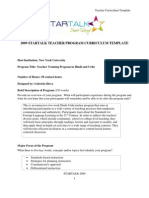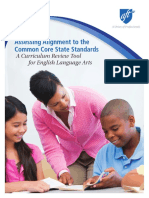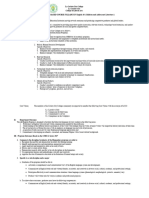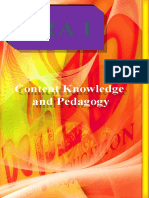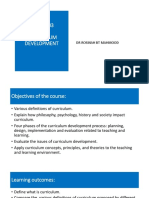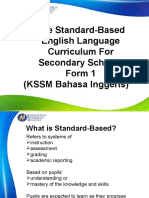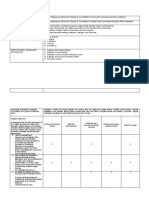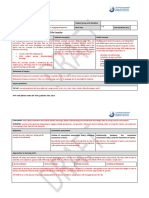The Clil Teachers Competences Grid PDF
The Clil Teachers Competences Grid PDF
Uploaded by
esmardoCopyright:
Available Formats
The Clil Teachers Competences Grid PDF
The Clil Teachers Competences Grid PDF
Uploaded by
esmardoOriginal Title
Copyright
Available Formats
Share this document
Did you find this document useful?
Is this content inappropriate?
Copyright:
Available Formats
The Clil Teachers Competences Grid PDF
The Clil Teachers Competences Grid PDF
Uploaded by
esmardoCopyright:
Available Formats
THE CLIL TEACHER’S COMPETENCES GRID
Pat Bertaux, Carmel Mary Coonan, María Jesús Frigols-Martín, Peeter Mehisto
The following grid aims to map competences that can support the development of a rich CLIL learning environment in a wide variety of contexts. These compe-
tences need to be further situated in the context of best practice in education in general. Moreover, the local context where CLIL is being implemented will place
its own demands on teachers. Taking these aspects into account, the grid is intended to serve as a framework for developing pre-service and / or professional
development training courses for CLIL teachers.
The grid is divided into two sections: a) underpinning CLIL; b) setting CLIL in motion. The first section is primarily focused on the competences and stake-
holder relationships that are essential to laying the foundation for establishing and maintaining a CLIL programme. The second focuses on the competences and
stakeholder relationships which are important to CLIL implementation.
UNDERPINNING CLIL
AREAS OF
COMPETENCES INDICATORS OF COMPETENCE
COMPETENCE
Programme Defining CLIL • Can explain how CLIL is related to and differs from other language and content learning approaches
parameters • Can name the various types of CLIL programming options and describe their characteristics
• Can articulate the key elements of the CLIL approach
• Can describe the benefits of CLIL
• Can describe common misconceptions about CLIL
Adopting an approach • Can describe national and/or regional policies concerning CLIL
to CLIL • Can draw on the experience of others
• Can define ways of ensuring programme goals are addressed in a balanced manner
• Can identify the type of CLIL best suited to one’s context
CLIL Policy /... Adapting CLIL to the • Can contextualise CLIL teaching with regard to the school curriculum
local context • Can link programme parameters and the needs of a particular class of students
• Can identify and engage with CLIL stakeholders, and help stakeholders (students, parents, inspectors, non-CLIL
teachers, etc.) manage expectations with regard to language and content learning targets
Integrating CLIL into the • Can describe how CLIL links to the national or regional curriculum
curriculum • Can deliver CLIL according to requirements of educational authorities
1 © P. Bertaux, C.M. Coonan, M.J.Frigols-Martín, P. Mehisto (2010)
AREAS OF
COMPETENCES INDICATORS OF COMPETENCE
COMPETENCE
CLIL Policy Linking the CLIL pro- • Can articulate how CLIL could be reflected in a school’s vision and mission statements, and in planning and public
gramme with school relations documents
ethos • Can foster the integration of the CLIL programme into school life (e.g., resource choices, action research, assemblies
or other school events)
• Can represent the interests of the CLIL programme and of the students when participating in school meetings, and
other forms of professional dialogue
Articulating quality • Can design and apply evaluation and assessment tools (tests, stakeholder surveys, portfolios, rubrics, etc.)
assurance measures for • Can interpret data from evaluations, and take related measures for programme improvement
CLIL
Target language Using Basic • Can communicate using contemporary social registers
competences for Interpersonal • Can adjust social and academic registers of communication according to the demands of a given context
teaching CLIL /... Communication Skills
(BICS) (Cummins)
Using Cognitive • Can read subject material and theoretical texts
Academic • Can use appropriate subject-specific terminology and syntactic structures
Language Proficiency • Can conceptualise whilst using the target language
(CALP) (Cummins)
Using the language of • Can use target language in:
classroom management - group management
- time management
- classroom noise management
- giving instructions
- managing interaction
- managing co-operative work
- enhancing communication
Using the language of • Can use own oral language production as a tool for teaching, through varying:
teaching - registers of speech
- cadence
- tone and volume
2 © P. Bertaux, C.M. Coonan, M.J.Frigols-Martín, P. Mehisto (2010)
AREAS OF
COMPETENCES INDICATORS OF COMPETENCE
COMPETENCE
Target language Using the language of • Can use the target language to:
competences for learning activities - explain
teaching CLIL - present information
- give instructions
- clarify and check understanding
- check level of perception of difficulty
• Can use the following forms of talk (Barnes, Mercer, et al.):
- exploratory
- cumulative
- disputational
- critical
- meta
- presentational
Course develop- Designing a course • Can adapt course syllabus so that it includes language, content and learning skills outcomes
ment • Can integrate the language and subject curricula so that subject curricula support language learning and vice versa
• Can design balanced formative and summative assessment tools measuring uptake in both language and content
• Can plan for the incorporation of other CLIL core features and driving principles into course outlines and into lesson
planning, including:
- scaffolding language, content and learning skills development
- continuous growth in language, content and learning skills development
- learner autonomy
- fostering critical and creative thinking
- helping students to link learning from various subjects in the curriculum
- using assessment for improving student learning (learning skills, content and language, as well as cognitive
development)
- fostering of BICS and CALP development
- fostering communication with other target language users
• Can select learning materials, structuring them or otherwise adapting them as needed
• Can identify and make use of learning environments in addition to the classroom (e.g., discussion forums, study
groups, school grounds, a community centre, the neighbourhood)
• Can select the language needed to ensure:
- student comprehension
- rich language and content input
- rich student language and content output
- efficient classroom management
3 © P. Bertaux, C.M. Coonan, M.J.Frigols-Martín, P. Mehisto (2010)
AREAS OF
COMPETENCES INDICATORS OF COMPETENCE
COMPETENCE
Partnerships Working with others to • Can cooperate with parents to support student learning by:
in supporting enhance student learn- - guiding parents in understanding and using the terminology and concepts of education, so they can better
student learning ing support their child’s learning
- raising awareness about productive and counterproductive strategies used by parents
- learning more about the student
• Can cooperate with school managers, educational authorities, and other decision makers
• Can express own professional concerns and needs to fellow teachers
• Can agree on common teacher training goals with fellow teachers
• Can analyse learner’s needs with fellow teachers
• In the case of team- and co-teaching, can develop efficient task-sharing
Building constructive • Can connect with each student personally
relationships with stu- • Believes in each student’s capacity to learn and avoids labelling students
dents • Is respectful of diversity
• Can create a reassuring and enriching learning environment
• Can support individual and differentiated learning
• Can engage SEN students
• Can adapt materials and strategies to students’ needs
4 © P. Bertaux, C.M. Coonan, M.J.Frigols-Martín, P. Mehisto (2010)
SETTING CLIL IN MOTION
AREAS OF
COMPETENCES INDICATORS OF COMPETENCE
COMPETENCE
Integration Merging content, • Can guide students in maintaining a multiple focus on content, language, learning skills and critical thinking
language and learning • Can support language learning in content classes
skills into an integrated • Can support content learning in language classes
approach • Can integrate content from several subjects and fields of knowledge
Implementation Lesson planning • Can design tasks that support planned learning outcomes
• Can design tasks that involve students using several learning styles
• Can find and adapt authentic material which speaks to student interests and learning needs
• Can identify and make use of learning environments beyond the classroom in a safe and efficient manner
• Can select, design and make judicious use of visual, auditory and multimodal support materials, and realia
• Can analyse content in terms of language needs
• Can create cross-curricular themes and related activities in cooperation with colleagues
Translating plans into • Can provide rich opportunities for linking previous and new knowledge
action • Can support students in moving from ‘context embedded’ to ‘context reduced’ materials (Cummins)
• Can provide rich input and experiences, approaching a topic from different perspectives
• Can make content and language accessible by helping students to turn their tacit / passive knowledge into explicit
/ active knowledge
• Can create opportunities for and support students in researching topics independently and through cooperation
with peers
Fostering outcome at- • Can adapt course content to language and subject curricula
tainment • Can set and negotiate content, language and learning skills outcomes with students
• Can guide students in systematically developing BICS and CALP
• Can help students develop meta-cognitive awareness
• Can guide students in developing productive cognitive habits
• Can help students to harness higher order thinking vis-à-vis content, language and learning skills
• Can forge links with other fields of learning
Second Lan- Knowing second • Can use the Common European Framework for Languages as a self-assessment tool
guage Acquisi- language attainment • Can use the CEF as a tool for assessing students’ level of attainment with colleagues
tion (SLA) /... levels • Can call on the CEF to define language targets in the CLIL class
5 © P. Bertaux, C.M. Coonan, M.J.Frigols-Martín, P. Mehisto (2010)
AREAS OF
COMPETENCES INDICATORS OF COMPETENCE
COMPETENCE
Second Lan- Applying SLA knowl- • Can distinguish between language learning and language acquisition and select language input accordingly
guage Acquisi- edge in lesson prepara- • Can identify words, terms, idioms and discourse structures that are new for the students in text, audio or audio-
tion (SLA) tion visual materials, and support comprehension thereof
• Can identify the language components needed by the learners for oral or written comprehension and produce sup-
port material
• Can identify the language components needed by the learners for complex oral or written production and produce
adapted resources (e.g. vocabulary, sentence and text types)
• Can, if necessary, plan prior language learning
• Can navigate the following concepts:
- intentional and incidental learning
- intelligibility
- error management & correction
- ‘teacher-speak’ (‘teacherese’)
- code switching
- code-mixing
• Can call on a range of strategies for fostering BICS and CALP development
Applying SLA knowl- • Can support students in navigating and learning new words, terms, idioms and discourse structures
edge in the classroom • Can call on a wide repertoire of strategies for supporting students in oral or written production
• Can use a wide range of strategies for scaffolding language use so as to produce high quality discourse
• Can navigate the concepts of code-switching and translanguaging, and decide if and when to apply them
• Can decide whether production errors are linked to language or content
• Can use a wide range of language correction strategies with appropriate frequency, ensuring language growth
without demotivating students
• Can use strategies such as echoing, modelling, extension, and repetition to support students in their oral produc-
tion
• Can develop a classroom culture where language learning is supported through peers and learner autonomy
Interculturality Promoting cultural • Can select and adapt authentic material from different regions or countries
awareness & intercul- • Can articulate key cultural parameters associated with the CLIL language
turality • Can guide students in developing cultural awareness
• Can guide students in acting in the ‘right way’ and saying the ‘right thing’ in the appropriate context
• Can raise learners’ curiosity about the culture(s) related to the CLIL language
• Can help students to move beyond superficial cultural stereotypes and learn about TL country/countries and their
people(s)
• Can initiate or support virtual or physical exchanges with students from other regions/countries
6 © P. Bertaux, C.M. Coonan, M.J.Frigols-Martín, P. Mehisto (2010)
AREAS OF
COMPETENCES INDICATORS OF COMPETENCE
COMPETENCE
Learning environ- Taking into account the • Can create a safe environment that encourages experimenting with content, language and learning skills
ment manage- affective side of learn-
ment ing
Making the CLIL learn- • Can anticipate, investigate and take into account learner needs regarding content, language and learning skills
ing process efficient • Can apply best practice in the following while also maintaining a triple focus on content, language and learning
skills:
- group management ( maintaining a focus on time, task and noise levels, fostering student self-regulation skills)
- giving instructions
- managing interaction (whole class discourse; peer cooperative work)
- enhancing communication (using clarification; checking for understanding; scaffolding; moving beyond one
question one answer; fostering critical and creative thinking; raising metalinguistic awareness; fostering student
autonomy)
- analysis of classroom dynamics and learning process by students
• Can consciously create opportunities for incidental learning of content, language and learning skills
Learner focus in Applying interactive • Can select learning activities in terms of classroom interaction (learner<->learner, learner<->teacher, teacher<-
the CLIL environ- methodology >teacher)
ment • Can support the development of learner autonomy through choice, planning outcomes, identification of scaffold-
ing needs and sources, and formative assessment
• Can give students a substantial ‘voice’ in classroom discourse
• Can create rich learning experiences, e.g.:
- group work that involves definition of each group member’s role
- mid-task analysis of work process and results, scaffolding language and content for interaction and task
completion
- peer enhancement
- tasks for those listening to presentation
- end-of-task assessment of group work processes and results, and using this in planning for next group task
• Can draw out current student knowledge, ways of organising knowledge, ways of thinking, and interests, and help
students to learn and use related language
7 © P. Bertaux, C.M. Coonan, M.J.Frigols-Martín, P. Mehisto (2010)
AREAS OF
COMPETENCES INDICATORS OF COMPETENCE
COMPETENCE
Learning skills Having knowledge and • Can scaffold learning along a scale from lower order to higher order thinking, e.g., remembering, understanding,
focus in CLIL awareness of cognition applying, analysing, evaluating, creating (Anderson and Krathwohl)
and metacognition in • Can identify, adapt and design materials suited to the students’ current level of cognitive development
the CLIL environment • Can identify syntactic structures and other language required for higher order thinking
• Can foster higher-order thinking about language, content and learning skills
• Can foster thinking about the interrelationships between language, content and learning skills
• Can provide frameworks for analysing content from multiple perspectives
• Can use an element of content as a springboard for stretching thinking
• Can use differences between languages to analyse how two cultures perceive one and the same concept
• Can use linguistic similarities and differences to develop metalinguistic awareness
Learning Knowing about and ap- • Can engage students in an assessment-for-learning culture including:
assessment and plying assessment and - making connections between planned outcomes, learning skills and processes, actual outcomes, planning and
evaluation in CLIL evaluation procedures negotiating strategies for future learning
and tools - using self and peer-assessment tools
- maintaining a triple focus on language, content and learning skills
• Can distinguish and navigate CLIL-specific characteristics of assessment and evaluation including:
- language for various purposes
- work with authentic materials
- communication with speakers of the CLIL language
- ongoing language growth (being alert to plateauing)
- level of comfort in experimenting with language and content
- progress in achieving planned content, language and learning skills goals
- developing all language skills
- distinguishing content and language errors
- carrying out assessment in the target language
• Can prepare students for formal examinations including high-stakes examinations
8 © P. Bertaux, C.M. Coonan, M.J.Frigols-Martín, P. Mehisto (2010)
AREAS OF
COMPETENCES INDICATORS OF COMPETENCE
COMPETENCE
Lifelong learning Keeping up with new • Can continue to evolve in the role of CLIL teacher through:
modelling developments - working systematically to apply new techniques and improve teaching
- trying out new materials and media
& - regular self-assessment of personal professional development needs
- updating knowledge by reading new articles and books on CLIL and pedagogy
Innovative - taking continuous professional development courses
teaching - taking part in regional, national or international CLIL networks and / or conferences
and learning • Can support colleagues in using innovative methodology
approaches • Can promote, and help students to adapt to, innovative learning techniques
Using ICT as a teaching • Can search for and download authentic material for use in the classroom
resource • Can help students develop media literacy
• Can guide students in using ICT in ways that are new for them and that enhance learning
• Can guide students in maintaining an appropriate balance between the use of electronic and non-electronic
sources
• Can articulate ethical and safety issues surrounding the use of ICT
• Can use ICT with learners to establish interregional and /or international exchanges
9 © P. Bertaux, C.M. Coonan, M.J.Frigols-Martín, P. Mehisto (2010)
You might also like
- KRA1 Content Knowledge and PedagogyDocument40 pagesKRA1 Content Knowledge and PedagogyFRANCIS VALE NAVITANo ratings yet
- CLIL - Content and Language Integrated Learning - PosterDocument1 pageCLIL - Content and Language Integrated Learning - PosterTường Cát100% (1)
- Element Checklist For MYP Unit Planners: Does The Unit Include The Following?Document8 pagesElement Checklist For MYP Unit Planners: Does The Unit Include The Following?Shantha KundapuraNo ratings yet
- Tiai Rubric 1Document11 pagesTiai Rubric 1api-357485951No ratings yet
- The Clil Teacher'S Competences GridDocument9 pagesThe Clil Teacher'S Competences GridAigul AitbaevaNo ratings yet
- Clil - Teachers CompetencesDocument9 pagesClil - Teachers Competencesapi-321099736No ratings yet
- NYU Teacher Curriculum Template Hindi UrduDocument16 pagesNYU Teacher Curriculum Template Hindi UrdumusicpamNo ratings yet
- PPST Priority Indicators For Proficient Teachers and Means of VerificationDocument27 pagesPPST Priority Indicators For Proficient Teachers and Means of VerificationJeremie Mariano Aban100% (2)
- Purposive CommunicationDocument6 pagesPurposive CommunicationBabylyn FelicianoNo ratings yet
- Topic 10 Comptence-Based Syllabus DesignDocument51 pagesTopic 10 Comptence-Based Syllabus Designnovita angreiniNo ratings yet
- M1 E1 L1 CLIL Toolkit Pages ExtractDocument8 pagesM1 E1 L1 CLIL Toolkit Pages ExtractTUTORIA 5BNo ratings yet
- ENGLISH-I Secondary Education Curriculum 2010Document38 pagesENGLISH-I Secondary Education Curriculum 2010Hari Ng Sablay100% (11)
- Unit Plan EvaluationDocument18 pagesUnit Plan EvaluationGirish MishraNo ratings yet
- Needs AnalysisDocument25 pagesNeeds AnalysisĐặng Thị Mỹ HồngNo ratings yet
- Lecture 5 (Cureent Trends, Part 2)Document26 pagesLecture 5 (Cureent Trends, Part 2)salobaidi0019No ratings yet
- Englishevaluationtool 2013Document12 pagesEnglishevaluationtool 2013ChrisNo ratings yet
- Goals and ObjectivesDocument40 pagesGoals and ObjectivesNguyễn Thu Hằng100% (1)
- Evaluating MYP Unit PlansDocument23 pagesEvaluating MYP Unit PlansLorraine SabbaghNo ratings yet
- Lecture 1 - HPGD1103 - E-Tutorial - Part1 - January 2023Document28 pagesLecture 1 - HPGD1103 - E-Tutorial - Part1 - January 2023Ihwanor AsrafNo ratings yet
- Clil Planning Tools For Teachers Do Coyle Edited Version DLDocument8 pagesClil Planning Tools For Teachers Do Coyle Edited Version DLAgustín DomenicaleNo ratings yet
- M2 - S1 - 02 - Guide To Implementation p.28-43Document18 pagesM2 - S1 - 02 - Guide To Implementation p.28-43Zakk McCoyNo ratings yet
- Speech and Theater ArtsDocument9 pagesSpeech and Theater ArtsMarjorie QuaboNo ratings yet
- Els 107-SyllabusDocument7 pagesEls 107-SyllabusCrisna Obillos100% (1)
- ELS 203 English Language Teaching Approaches and MethodsDocument9 pagesELS 203 English Language Teaching Approaches and Methodsmoralesperpetua645No ratings yet
- Digitalized IPCRF Form 2020 2021 Final For Master TeacherDocument19 pagesDigitalized IPCRF Form 2020 2021 Final For Master TeacherChin CustodioNo ratings yet
- Assessmnet 2 - Module 1Document10 pagesAssessmnet 2 - Module 1Mary Rose Vertudazo100% (1)
- Contextualization Latest FINALDocument36 pagesContextualization Latest FINALJohanNo ratings yet
- NSC English HL Cat 2024Document23 pagesNSC English HL Cat 2024Daphne MbireNo ratings yet
- Teaching Pragmatics in EFL Classrooms 2029-Trang-2Document9 pagesTeaching Pragmatics in EFL Classrooms 2029-Trang-2Anh Dung NguyenNo ratings yet
- The Management Cycle inDocument21 pagesThe Management Cycle inMaria Jannettes Bustrillos RenegadoNo ratings yet
- SD Module 1 Session 3Document98 pagesSD Module 1 Session 3teacherjjane001No ratings yet
- Training Modules 2023Document5 pagesTraining Modules 2023El Houssaine DrissiNo ratings yet
- Chapter 2 ContinuationDocument25 pagesChapter 2 Continuationjohn Michael AboniteNo ratings yet
- The Need For Content and Language IntegrDocument14 pagesThe Need For Content and Language IntegrandreshostiaNo ratings yet
- Further Guidance For Developing MYP Written CurriculumDocument6 pagesFurther Guidance For Developing MYP Written CurriculumdineshnpNo ratings yet
- Group 2 Reports and ReportersDocument16 pagesGroup 2 Reports and ReportersRamon III ObligadoNo ratings yet
- Pud 1 TercerosDocument23 pagesPud 1 TercerosBoris JuelaNo ratings yet
- Language Curriculum For Secondary Schools Course OutlineDocument3 pagesLanguage Curriculum For Secondary Schools Course Outlinemoeknup100% (2)
- Fac LearnDocument14 pagesFac LearnveehneeNo ratings yet
- SYL EL118 Language Learning Materials DevelopmentDocument9 pagesSYL EL118 Language Learning Materials DevelopmentREAS FAITHNo ratings yet
- CLIL Planning Tools For Teachers Do Coyle - Edited VersionDocument8 pagesCLIL Planning Tools For Teachers Do Coyle - Edited VersionYamith J. Fandiño75% (4)
- Syllabus For Engl11 Purposive Communication A. Course Information Course Number Engl 11 No. of Units 3Document14 pagesSyllabus For Engl11 Purposive Communication A. Course Information Course Number Engl 11 No. of Units 3Ethel Joy ABARETANo ratings yet
- Lecture 1 Hpgd1103 E-Tutorial Part1 May 2021Document28 pagesLecture 1 Hpgd1103 E-Tutorial Part1 May 2021NUR FAIZAH BINTI ROSLAN STUDENTNo ratings yet
- Communicative Competence SlidesDocument8 pagesCommunicative Competence SlidesNadia SimonNo ratings yet
- Microcurricular Planning by Skills and Performance Criteria Norma 2017Document3 pagesMicrocurricular Planning by Skills and Performance Criteria Norma 2017Leo JoshNo ratings yet
- Report Beed 9Document19 pagesReport Beed 9achasunshine8No ratings yet
- University of The CordillerasDocument7 pagesUniversity of The CordillerasNorma AbdulNo ratings yet
- BEEd 3A TTL 2Document11 pagesBEEd 3A TTL 2johnloyd.disto.eNo ratings yet
- Q2 Week 3Document3 pagesQ2 Week 3kimbeerlyn doromasNo ratings yet
- English Programmes: FOR Basic EducationDocument19 pagesEnglish Programmes: FOR Basic EducationFaouzi HarrathiNo ratings yet
- Philippine College of Technology Basic Education Department Senior High SchoolDocument10 pagesPhilippine College of Technology Basic Education Department Senior High SchoolLoralee BragatNo ratings yet
- KRA Objectives: Portfolio Assessment (For Ipcrf) T1-T3Document18 pagesKRA Objectives: Portfolio Assessment (For Ipcrf) T1-T3Srtdylue PamintuanNo ratings yet
- 3 SbelcDocument93 pages3 SbelcDamiafazirahNo ratings yet
- Assessment in Major Subjects (Measurement by The Physical Educator)Document8 pagesAssessment in Major Subjects (Measurement by The Physical Educator)Jaype MedidaNo ratings yet
- SpeakingDocument33 pagesSpeakingEduardo TasisNo ratings yet
- Teaching and Assessment of Literature Studies Syllabus-Obe Based (Final)Document13 pagesTeaching and Assessment of Literature Studies Syllabus-Obe Based (Final)Edelyn CuriosoNo ratings yet
- MYP Unit Planner: INQUIRY: Establishing The Purpose of The InquiryDocument4 pagesMYP Unit Planner: INQUIRY: Establishing The Purpose of The InquiryMuhammad IqbalNo ratings yet
- Pathfit 2 Syllabus1.EnglishDocument9 pagesPathfit 2 Syllabus1.EnglishElla Pagran ArcanNo ratings yet
- MC Course Outline Fall 2023 SAFDocument15 pagesMC Course Outline Fall 2023 SAFUmer NaeemNo ratings yet







